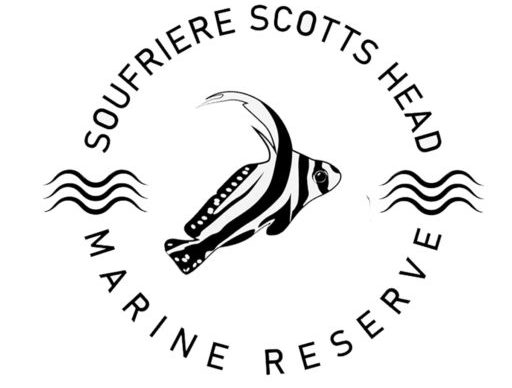There are more than twenty named dive sites located within the boundaries of the SSMR. Ranging from ‘east” (one dive flag) to Difficult (three dive flags) here are some of the dives sites:
The Suburbs ![]()
![]()
![]() and Village
and Village ![]()
![]()
![]()
The Suburbs and Village are richly covered rocky drop-offs that are visited by schools of black durgons, huge barracuda, frequent turtles, and often some big stingrays. This is a much wilder area and one never knows what might pass by. But on the quiet days when nothing exciting happens, one is given time to enjoy the magnificent coral life. Huge barrel sponges and walls of incredibly dense deep-water seafans which frequently conceal shy seahorses, hundreds of colourful crinoids and sponges, like splotches of paint from a deranged artist’s pallette.
Condo ![]()
![]()
Condo is also located on the Atlantic side and is a huge chunk of rock, sitting in sixty feet of water on a sandy, sloping bottom. Swim-throughs, overhangs and recesses are unique features of the Condo.
Scott’s Head Pinnacle ![]()
![]()
Northwest of the Condo, the Atlantic and Caribbean Seas converge, creating some of Dominica’s most impressive dive sites. Scotts Head Pinnacle is justifiably one of the island’s most famous dive sites; divers regularly request repeat visits to this site. The dive begins on Swiss Cheese, a large rock formation home to the well-known Soldierfish Cave. Not actually a cave, this swim-through is usually packed with soldierfish and grunts who form a curtain in front of you, briefly parting to swallow you into the school as you pass through. Crossing a flat area of coral encrusted rock formations leads to the Pinnacle itself. At a depth of only 35 feet, a picturesque swim-through bisects the pinnacle, bringing you to the “other side” — a steep wall on the inside of the volcanic crater that falls off to more than 120 feet. The swim-through is usually full of blackbar soldierfish, grunts and lobster. The wall is dominated by deepwater seafans and other colourful gorgonians.
Crater’s Edge ![]()
![]()
![]()
Continuing northwest from Scott’s Head Pinnacle there is a volcanic ridge that leads out to Crater’s Edge, another personal favourite. This site is guaranteed to please. I have spent entire dives never looking at the pinnaacle, but rather staring out into the blue at the masses of black jack, bar jacks, rainbow runners, tuna, yellowtail snapper and cero, all pursuing schools of baitfish who dart back and forth in a futile attempt to escape their hunters. If you can peel your eyes from this frantic activity and look toward the pinnacle you will see waterfalls of creole wrasse and brown and blue chromis. Behind all this activity is a spectacular wall covered in colourful sponges and giant barrel sponges. It is not uncommon to be followed by one or two giant barracuda escorting you from the area. The Crater’s Edge Pinnacle can easily be circumnavigated during a single dive, or one could follow the volcanic ridge towards Scott’s Head Pinnacle.
Scotts Head Drop-Off ![]()
![]()
Coming around the corner from these dive sites, one enters the Soufriere/Scotts Head Bay. This area is more protected from the elements and one rarely encounters waves or currents. Starting on the most western point is Scott’s Head Drop-Off (Scott’s Head Point), my second favourite dive site on the island. This wall is spectacular at any depth, from forty to one hundred feet. It is an incredibly colourful dive with pink and azure vase sponges, orange icing sponges, yellow tube sponges, and green rope sponges. The many small nooks and crannies hide lobster, crabs, and many different kinds of cleaner shrimp. The end of this dive consists of a fifteen foot safety stop that is so vibrant that it could be a dive all in itself.
Soufriere Pinnacles ![]()
North of the village of Soufriere, the first dive site is Soufriere Pinnacles, a popular second-dive site. This summer this dive site was noted for having six frogfish and two seahorses.
L’Abym and Witches Point (La Sourciere) ![]()
Soufriere Pinnacles leads into L’Abym, a fifteen hundred foot wall that plunges straight down from the cliff face. Some parts of the wall are extremely steep, dropping off into the deep blue. It is also common to find frogfish and seahorses here.
Dangleben’s Pinnacles ![]()
![]()
My favourite dive site north of Soufriere village is by far Dangleben’s Pinnacles. A series of five pinnacles ranging in depths from forty to eighty feet, they are covered in every imaginable form of sponge and coral. In the winter months, the southernmost pinnacle becomes a feeding frenzy of barjacks, horse-eye jacks, crevalle jacks, cero and the occasional barracuda busily hunting schools of baitfish. All this is back-dropped by waterfalls of mating blue creole wrasse. As a famous Divemaster once said, “If you’re tired of Dangleben’s, you’re tired of life.”
Coral Gardens and Point Guignard ![]()
![]()
In shore from Dangleben’s Pinnacles is Coral Gardens, a shallow and colourful dive with large areas of finger and pencil coral. Just to the north is Point Guignard, a gradually sloping area rich with small creatures like seahorses, nudibranches and sea slugs.
Champagne Reef ![]()
Champagne Reef is the northernmost dive site in the Marine Reserve and is Dominica’s most famous diving and snorkeling site. This sub-aquatic hot spring is in about fifteen feet of water and spews forth hot water and bubbles, giving the effect of diving in champagne. It is quite common to see schools of squid and huge stoplight parrotfish around this area.
